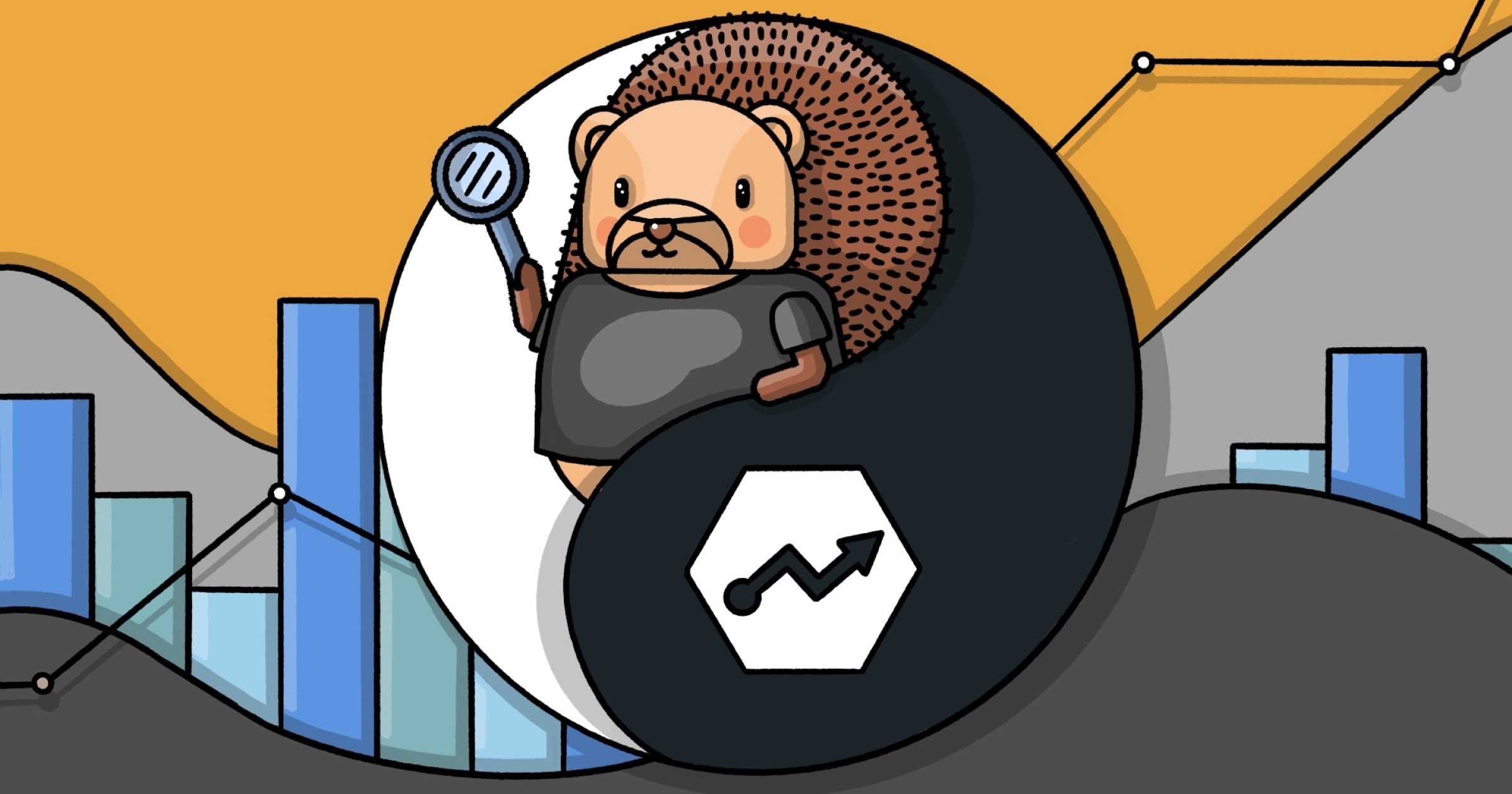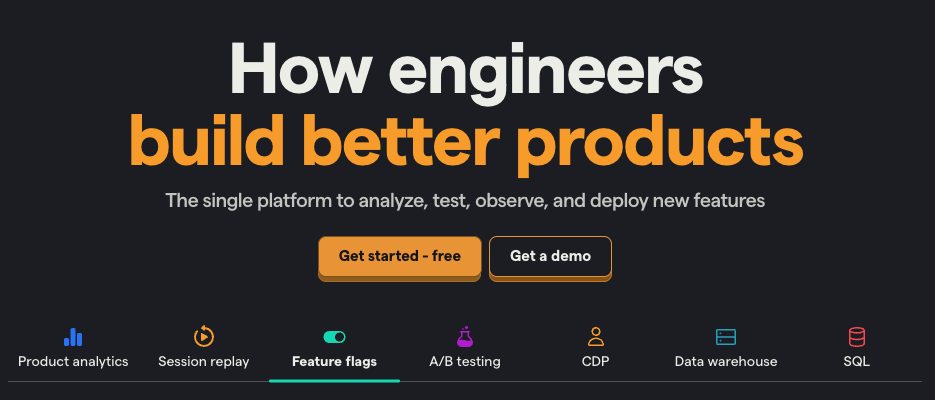In-depth: PostHog vs Statsig
Dec 14, 2023

On this page
- How is PostHog different?
- 1. We're an all-in-one platform
- 2. We're open source and transparent
- 3. We ship weirdly fast
- Comparing PostHog and Statsig
- Platform
- Experimentation
- Feature management
- Product analytics
- Pricing
- Integrations
- Security and compliance
- Frequently asked questions
- Who is PostHog useful for?
- Who is Statsig useful for?
- How much does PostHog cost?
- How much does Statsig cost?
- Does PostHog offer discounts for nonprofits and startups?
PostHog and Statsig both offer A/B testing and feature flags, but they're different in two important ways:
Statsig is a dedicated testing platform that offers advanced statistical methods for running tests. It's ideal for data scientists and growth teams in large enterprises who need to conduct complex A/B testing.
PostHog is an all-in-one platform for engineers and product teams who want a more straightforward approach to experimentation. In addition to A/B testing, it offers feature flags, advanced product analytics, session replays, surveys, and more.
This post compares their platforms, experimentation features, pricing, and more.
How is PostHog different?
1. We're an all-in-one platform
PostHog brings together all the tools engineers need for testing, releasing, and measuring the success of new features. Feature flags and A/B testing are only part of a suite of tools PostHog offers.

PostHog combines usage, performance, and behavioral data with flags and experiments. Having all these product and data tools together enables you to do better analysis of shipped features and make better decisions about what you are building next.
2. We're open source and transparent
PostHog is built with transparency at its core. Not only do we work in the open and give full access to our source code, we also enable others to build integrations or other services on top of PostHog, open their own PRs, or give feedback on our roadmap. PostHog's open app framework makes it easy to integrate internal tools, an advantage closed-source products like Statsig can't offer.
3. We ship weirdly fast
We update our changelog with a recap of new features every week, and often there’s even more in beta testing. We work hard to keep PostHog on the cutting edge and respond quickly to feedback from our users.
Comparing PostHog and Statsig
Platform
| PostHog | Statsig | |
A/B testing Test changes and analyze impact | ✔ | ✔ |
Feature flags Roll out features safely; toggle features for cohorts or individuals | ✔ | ✔ |
Product analytics Track events and conversion; analyze user behavior | ✔ | ✔ |
Dynamic config Replace hard-coded values in your app with config values | ✖ | ✔ |
Session replays Watch real users use your product; debug behavior | ✔ | ✖ |
User surveys Ask users for qualitative feedback and gather responses | ✔ | ✖ |
Notebooks Collaborate on analysis in shareable notebooks | ✔ | ✖ |
Open source Code publicly accessible | ✔ | ✖ |
Data warehouse storage Store large amounts of analytics data | In beta | ✖ |
Data warehouse experiments Run A/B tests natively on data in your existing warehouse | ✖ | ✔ |
Experimentation
Both tools enable you to run A/B/n and multivariate tests, set custom goals, and calculate statistical significance, but:
Statsig offers some more advanced testing techniques, such as multi-armed bandit, mutually exclusive, and holdout tests. It also lets you choose between Bayesian and Frequentist engines, and supports Bonferroni correction.
PostHog provides a more intuitive user interface and simpler setup process, making it ideal for teams who prefer a more straightforward approach to experimentation, and tight integration with its other powerful tools.
| PostHog | Statsig | |
Custom goals Customize metrics that a test tracks | ✔ | ✔ |
Secondary metrics Monitor impact on unrelated metrics | ✔ | ✔ |
Statistical significance calculation Calculate if changes make a statistically significant impact | ✔ | ✔ |
Split testing Split participants into groups | ✔ | ✔ |
Multivariate (A/B/n) testing Test multiple variants of a change | ✔ | ✔ |
Recommended run time Calculate the recommended run time for your experiments | ✔ | ✔ |
Statistics engine How the results of an experiment are calculated | Bayesian | Bayesian, Frequentist |
Holdout testing Withhold multiple features to measure cumulative impact | Partial | ✔ |
Multi-armed bandit Optimize tests automatically by allocating traffic to the best performing variant. | ✖ | ✔ |
Mutually exclusive experiments Isolate user groups for simultaneous, independent experiments | ✖ | ✔ |
Bonferroni correction Includes α correction when tests are being performed simultaneously | ✖ | ✔ |
- Holdout testing: It's possible to run a holdout test across multiple A/B tests in PostHog. However, the process is more manual than Statsig's, which has built-in functionality to do this.
Feature management
While both offer the core features you need, Statsig's feature flags are boolean-based, while PostHog supports multivariate flags with JSON payloads and boolean flags. This provides greater flexibility in testing and deploying different variations of a feature, making them more suitable for complex rollouts.
| PostHog | Statsig | |
Boolean flags Simple flags returning true or flag | ✔ | ✔ |
Multivariate flags Flags with multiple customizable values | ✔ | ✖ |
Payloads Flags with string, number, or JSON payloads | ✔ | ✖ |
Percentage rollouts Target percentages of a group | ✔ | ✔ |
Custom targeting Target users based on user properties, custom contexts | ✔ | ✔ |
Scheduling Schedule flags to turn on or off | ✔ | ✔ |
Environments Manage flags for dev, stage, prod | Partial | ✔ |
Bootstrapping Flags available on frontend application load | ✔ | ✔ |
Early access management Manage betas, test features | ✔ | ✖ |
Product analytics
Both PostHog and Statsig offer the functionality you expect from product analytics tools, such as dashboards, graphs, and funnels. However:
PostHog provides deep insights into how users are interacting with your product. It includes features such as lifecycle, stickiness, correlation, and retention analysis.
Statsig does provide some additional insights, such as retention analysis, but its main focus is to use product analytics to set up metrics to run A/B tests on.
| PostHog | Statsig | |
Autocapture Capture events without manual logging | ✔ | ✖ |
Dashboards Combine insights into shareable dashboards | ✔ | ✔ |
Graphs and trends Build custom insights and visualizations | ✔ | ✔ |
Cohorts Combine users based on properties and events for group analysis | ✔ | ✔ |
Group analytics Track metrics at a company level | ✔ | ✔ |
Funnels Track users through a sequence of events | ✔ | ✔ |
Retention analysis Visualize which users stay, for how long | ✔ | ✔ |
User paths Track user flows and where they drop-off | ✔ | In beta |
Correlation analysis Suggested events and properties that lead to success or failure | ✔ | ✖ |
Lifecycle analysis Understand who is dormant, churning, and thriving | ✔ | ✖ |
Stickiness insights See how many times users perform an event in a period of time. | ✔ | ✖ |
Formulas Use custom formulas to calculate unique insights | ✔ | ✔ |
Query editor Write your own queries in SQL | ✔ | ✖ |
Pricing
Both PostHog and Statsig offer simple, transparent pricing.
Statsig has a free plan for up to 1 million metered events (a metered event is any feature flag, A/B testing, or logging event). Thereafter, it's $150 per month for up to 5 million metered events, and then $50 per every 1 million events.
PostHog’s prices for A/B testing and feature flags requests are as follows:
- Free up to 1 million requests.
- $0.000100 per request between 1-2 million requests – i.e., $100 for 1 million requests.
- $0.000045 from 2-10 million requests – i.e. $45 for 1 million requests
- Progressively cheaper beyond 10 million requests.
You can, however, significantly reduce feature flag and A/B testing requests by using PostHog's backend local evaluation, potentially saving you a considerable amount of money.
Note: Product analytics are billed separately from A/B testing and feature flag requests. See our analytics pricing for more details.
Integrations
Both PostHog and Statsig have a range of integrations that enable them to import, export, enhance, and make use of data, but PostHog being open source means you can create your own integration.
Below is a sample comparison of PostHog and Statsig's integrations. Be sure to checkout PostHog's full list of integrations.
| PostHog | Statsig | |
Imports Import data from source | ✔ | ✔ |
Exports Export data to other sources | ✔ | ✔ |
Zapier Trigger Zapier automations | ✔ | ✖ |
Sentry Connect to Sentry data | ✔ | ✖ |
Datadog Capture flag data in Datadog | ✖ | ✔ |
Slack Alerts for Slack | ✔ | ✔ |
Microsoft Teams Alerts for Microsoft Teams | ✔ | ✔ |
Security and compliance
Both PostHog and LaunchDarkly enable companies to remain secure and compliant with privacy regulations. Companies can customize the levels of user privacy related to these platforms to their needs.
An advantage of Statsig is that it can be made HIPAA-compliant, while PostHog cannot. This makes Statsig better suited for healthcare companies.
| PostHog | Statsig | |
User privacy options Anonymize users, drop personal data | ✔ | ✔ |
History, audit logs Manage and view flag edits and related users | ✔ | ✔ |
GDPR-ready Can be compliant with GDPR | ✔ | ✔ |
HIPAA-ready Can be compliant with HIPAA | ✖ | Enterprise |
SOC 2 SOC 2 security certification | ✔ | ✔ |
2FA Enforce login with two-factor authentication | ✔ | ✔ |
SAML/SSO Use SAML or single sign-on authentication | Enterprise | Enterprise |
Approvals Require approvals to change flags | ✔ | ✔ |
Permissioning Control who can edit and modify flags | ✔ | ✔ |
Frequently asked questions
Who is PostHog useful for?
PostHog is built for startups and their engineers. It provides all the tools startups need to build successful products. The people who find PostHog most useful are founders, product engineers, and growth engineers.
Companies that use PostHog feature flags and experiments include Y Combinator, Vendasta, and AssemblyAI.
Who is Statsig useful for?
Statsig is for teams that require advanced experimentation capabilities and more sophisticated statistical methods. It's ideal for data scientists and growth teams who need to conduct complex A/B testing.
Teams that frequently run multiple experiments on the same surface concurrently will appreciate Statsig's ability to handle mutually exclusive experiments and implement Bonferroni correction.
How much does PostHog cost?
Feature flags and experiments are free for up to 1M requests per month. Beyond that, it costs $0.0001/request (or $1 per 10,000 requests). There are discounts for high-volume users, non-profits, and startups.
Other products, like product analytics and session replay, have separate but similarly structured pricing.
How much does Statsig cost?
Statsig is free up to 1M requests per month. Thereafter, it's $150 per month for up to 5 million metered events, and then $50 per every 1 million events thereafter.
Does PostHog offer discounts for nonprofits and startups?
Yes, PostHog offers both. Nonprofit organizations can contact our team and are usually eligible for a 50% discount, while startups can sign up for $50,000 of free credit (and a host of other perks) in the PostHog for Startups program.
Ready to find out more?
